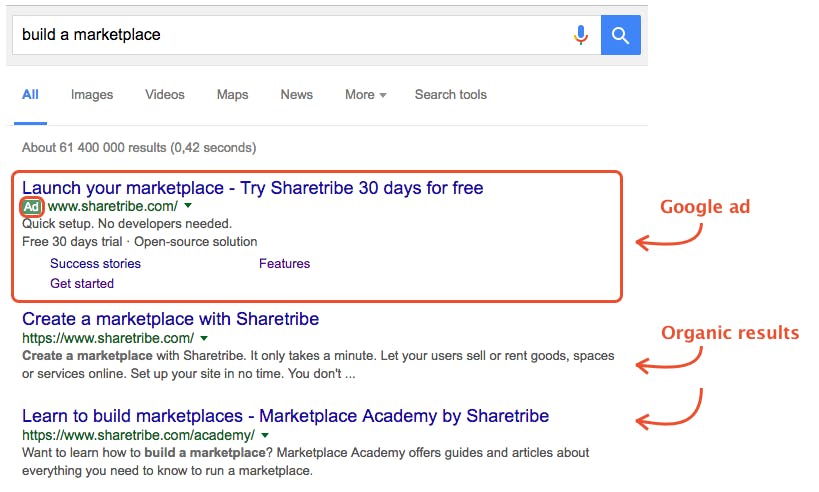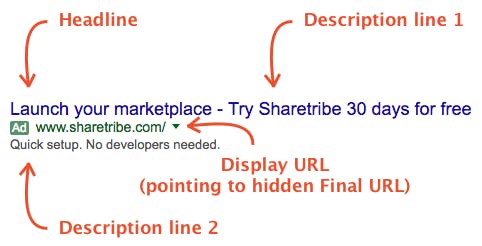How to get started with Google Ads for your marketplace
The basics of setting up your first-ever Google Ads campaign.
Published on
Last updated on

This article explains the basics of using Google Search Ads to increase your traffic. For more marketing tips, check out the marketplace marketing & growth articles library.
Google Ads is one of the easiest self-service online advertising platforms. It has the largest global reach, and can be used in a very cost-efficient way, making it a perfect candidate to start your marketplace advertising. In this article, we will discuss the basics involved in setting up your first advertising campaign.
One of the faster—but also more expensive—ways to grow your marketplace is through the use of paid traffic. While not being cheap, it is possible to very specifically control your costs, making it an option that fits any budget. Paid traffic is also not overly complicated. You will see the results of your efforts almost instantly.
In the next few paragraphs, we will introduce you to the world of paid traffic using one of the most powerful paid advertising tools at your disposal: Google Ads (previously Google AdWords).
If you regularly use Google, you have most likely come across thousands of Google Ads advertisements. Google Ads can come in a number of different formats, but the easiest one to get started with is search ads. Search ads look like search results that show up above the organic results.

The ads are selected based on the keywords of your search query. This is why they are so effective: the ads are related to whatever the user is searching for. They can provide an answer to whatever the user is looking for. In the case of your marketplace, these ads can be very effective if you target the right keywords.
A small disclaimer: this article aims to familiarize you with the use of Google Ads advertising to get initial traffic to your new marketplace. There is no guarantee that it will be a profitable campaign. It takes time to develop a large-scale profitable campaign. What is more, paying a lot for users might lead to a situation where your marketplace unit economics no longer work. Including low-cost channels like content or email marketing to your growth mix can be recommended.
If you want to make paid advertising a fundamental part of how you get traffic, a wealth of information is available on the internet. Some highlights include Google’s own instructions, free and paid Udemy courses and great blogs such as Wordstream and PPChero.
Once you have created a Google Ads account, Google will entice you to start your campaign immediately. However, setting up a good campaign requires careful thinking and preparation. We recommend that you first do some groundwork, at least related to the following topics:
- Ad copy
- Keywords
- Budget
Coming up with good ad copy is difficult. It is a process of iteration. You should have at least 2–3 different versions, but you can start off with just one. A search ad, or standard text ad, contains five elements:

Headline (max 25 characters)
The headline is the first line that people read. It is usually a good idea to have a call to action (CTA) that is related to the keywords you target. For example, if you have a bike rental marketplace, Rent a bike would be a good headline.
Description line 1 (max 35 characters)
This line is displayed either to the right of the headline or as the first sentence below the Display URL. The location depends on the viewer's device and screen resolution. In other words, it needs to function both as an extension of the headline as well as a descriptive introduction. It is a good place to share your unique value proposition. To stick with the earlier bike rental marketplace example: Is it easier to rent a bike on your marketplace? Or cheaper? Or faster?
Description line 2 (max 35 characters)
The last part of your description that can be used to extend your unique value proposition or another message that will convince the users to click and visit your site.
Display URL
This is the green website address that shows users where they will end up. You can use your plain domain name here, or a domain with a subfolder. If you plan on directing users to a targeted page, it might be a good idea to show this. For example, you can use
www.rentabike.com/nyc/centralpark if your ad specifically targets Central Park bike rentals.
Final URL
This is the actual link that people will be directed to. It can be as long as you want. If you use a web analytics service such as Google Analytics, you can append UTM tracking tags to the URL. This will allow you to track the efficiency of your different campaigns. (Note that if you use Google Analytics, you should connect Google Ads with your Google Analytics account for automated tracking.) In the case of our example bike rental marketplace, the Final URL might be: https://www.rentabike.com/nyc/centralpark?utm_source=google&utm_medium=cpc&utm_campaign=campaign_centralpark
Try to create 2-3 ads before starting your campaign.
This is arguably the most important part of your campaign. Keywords determine when your text ad will show up and how much they will cost. The goal is to be as precise as possible, while also being broad enough to get enough traffic. Google has a great Keyword Planner, but it is only available once your campaign is running, so we have to start somewhere else. A good strategy is to open a spreadsheet, and simply list all the keywords you can think of. Ask yourself what phrases someone would type in if they are looking for whatever your marketplace has to offer. There is no need to list every possible variation such as plurals and different word ordering.
It is a good idea to learn how Google’s keyword matching works. It is an incredibly smart system with several different keyword matching types. With a broad match, if you use bike rental as the keyword, the ad will also be shown for people who search for related phrases, such as rent a bicycle. This can work for certain marketplaces, but if your keyword is very broad, the ad will be shown for unrelated search queries.
You can choose a more restrictive match type by using phrase match, which will only show your ad when the search query includes your keywords. To use phrase matching, add quotation marks around your keywords. For example, with “bike rental”, your ad will no longer be shown for rent a bicycle, but will still show for rental bike, bike rental, bike rental site, and other close variations of your phrase.
If you want to be really precise, use exact match by putting brackets around your phrase. [bike rental] will only show for bike rental and close variations of that exact phrase.
The final matching type is negative match, which excludes searches with the specified keyword. These are written with by adding a minus sign before the keyword. In our example, we should exclude -motor so that our ad does not show for people searching for motor bike rental.
Let us pretend that your bike rental marketplace is servicing the New York City area. To start your campaign, your keyword list could look something like this:
Broad Keywords
central park bike rental
bike rental central park
central park bike rentals
nyc bike rental
bike rentals nyc
rent a bike nyc
new york bike rental
rent a bike new york
bike hire central park
new york city bike rental
bike rental central park nyc
rent bike nyc
central park bike hire
rent bike new york
rent a bike in new york
bike rental manhattan
Bike rental brooklyn
bike rentals in nyc
rent a bike in nyc
bike hire nyc
bike hire new york
Negative keywords
-motor
-scooter
-tour
As you can see, these are all broad keywords. There is an overlap between many of the phrases and some of them could be matched with the same search query. It doesn’t hurt to list them anyway, as Google will pick the closest match.
As you can see from the example keyword list, some keywords specifically target certain locations in New York. This is because, for our fictional marketplace, we want to group our offering by location. People will likely search for rental bikes in a certain area, which is why our grouping makes sense. Your own marketplace will most likely have a similar way of grouping or categorizing your offerings. If your marketplace is about catering services, you could have categories for breakfast, lunch, and dinner, or for vegetarian, vegan, and gluten-free food.
If you have these kinds of categories or subcategories in your marketplace, making separate ad groups for them is recommended. To understand why you need to know a bit about the hierarchical structure of the Google Ads environment. Your Ads account can contain multiple campaigns. A campaign can contain multiple ad groups. An ad group consists of at least one keyword and one ad but can contain many of each. Each keyword in an ad group can trigger any of the ads from that group. Ad groups should be built around sets of related keywords, and ads should have headlines and descriptions related to the group's set of keywords. The budget (more about that later) is set at the campaign level, so no matter how many ad groups you make, it is easy to control costs.

To get back to our example, locations are a natural choice for ad groups. “Central Park” would contain all the keywords related to Central Park and have ads that contain "Central Park" in the headline and/or description. Ideally, even the Destination URL should point to a landing page that shows all the available bikes from your marketplace in the Central Park area. Your ads are much more likely to receive clicks when they contain the exact words that potential customers are looking for—such as “central park rental bike”. This will improve the Click-through rate (CTR), which in turn will improve your Quality Score (more about that later).
Now that we have discussed the ad copy and keywords, let us turn to what was most likely the first question on your mind: how much will this cost you? This is (almost) entirely up to you. The cost is determined by your budget. You can set a daily budget for your campaign, and this will mostly be respected by Google. One day it might spend a bit more, and often it will spend a bit less.
The number of clicks you get for that budget is less straightforward. You pay Google for each click your ad receives, so it depends on the cost-per-click, or CPC. The CPC is determined by a bidding process between you and other advertisers. Some keywords might be very cheap as there are only a few other bidders, while other keywords are more popular and thus much more expensive. Other factors—such as the Quality Score of your ad and keyword combination—influence the price as well, but that is something to worry about later on. In very general terms, you need to outbid the competition for a certain keyword in order for your ad to be shown. Google will charge you the minimum price required for you to win the bid.
This is all very complicated, especially as you probably do not have a very good idea of how much a click is worth, or what is a competitive bid for your ad and keyword combination. Therefore, when it comes to bidding, using an automated bidding strategy is a good idea in the beginning. Since the goal of our campaign is to drive traffic, Maximize for Clicks is likely the most relevant strategy. The only thing you need to decide is how much you want to spend on a daily basis.
Keep in mind that it will probably take a bit of time before your campaign starts running efficiently. This is because Google needs to learn which keyword and ad combinations are most effective for your campaign. Start with a low budget, and see how it gradually starts performing.
Google's thorough onboarding process should help you get started with your first campaign. We will not go through a step-by-step reproduction here. Armed with the information that you gathered using the instructions above—your ad copy, your keywords, and your budget—you should be able to start a reasonable campaign.
Tracking your Google Ads campaign is key to optimizing how well it performs. As mentioned before, connecting your Google Ads with your Google Analytics account is a smart move. It will allow you to see how the traffic that comes in through your campaign behaves. If, for example, the bounce rate is very high, you might want to take another look at your keywords. You could be targeting keywords that are not in line with what your marketplace offers. Or one of your keywords may also mean something else. Google gives an example of an optometrist who targets glasses, which results in visitors looking for wine glasses or drinking glasses. In this case, adding negative keywords would be smart.
Another good strategy to improve your campaign is to test different ad copy. After all, it is unlikely that your first copy is the best one. Better ad copy will improve your CTR, which improves your Quality Score, which in turn lowers your cost per click.
If you only have one ad per ad group, consider writing one or more alternative ads. Google will initially show the different ads evenly and will start automatically optimizing the ad group to eventually only show the best performing ads. Once you have an ad that performs significantly better, you can remove the other ones.
It is good to start by writing alternative ad copy that is very different from your existing version. If you only make minor tweaks, it might take a long time before you find out which ad is performing the best.
Here is a great video that explains this process in more detail.
- Think about your marketplace supply as well. This article focused on getting visitors from the demand side of your two-sided marketplace. Since supply might give you more value in the long run, consider using paid marketing to attract them to your marketplace. That’s what Uber did.
- Prepare well. Spend plenty of time finding the right keywords and crafting your text advertisements. It will save you time and money in the long run.
- Be patient. Your campaign won’t be perfect from the start. Google Ads will automatically optimize your campaign for you, but that also takes some time. There are thousands of people in the world who make their living solely by analyzing, optimizing, and running campaigns, so getting it right the first time is highly unlikely. It might turn out that paid traffic is not a viable option for your marketplace, especially if your target audience doesn't use online search or if the competition is driving up ad prices.
- Start slow. Unless you have a lot of money to burn and you want visitors above all else, starting slow is generally a good idea.
This article showed you the very basics of starting your first Google Ads campaign. It should enable you to drive the first paid traffic to your marketplace and investigate if it is a suitable channel for you.
As your marketplace grows, a lot more can be done to expand and optimize your ad spend. As an example, check out what Airbnb and Uber are doing with Google Ads. There are also many other paid traffic channels (Facebook, Twitter, and Instagram, to name a few) that might work much better for your particular marketplace.
However, in general, paid advertising should only be one of many channels that drive traffic to your marketplace. Since it can be costly, and you have to pay for each individual visit, it should probably not be your main channel. Read more about how to grow a marketplace to learn about other, more sustainable ways to grow.
You might also like...

Marketplace metrics: 26 key metrics and how to use them
What metrics should a marketplace founder track? And how to translate what you track into action? Here’s how to identify and track the key metrics, how to separate them from vanity metrics, and how to make concrete decisions based on reliable data.

How to launch your marketplace
Strategies that bring demand to your freshly opened marketplace platform.

How to start with branding your marketplace
Use the brand strategy canvas to find your unique marketplace positioning.
Start your 14-day free trial
Create a marketplace today!
- Launch quickly, without coding
- Extend infinitely
- Scale to any size
No credit card required
